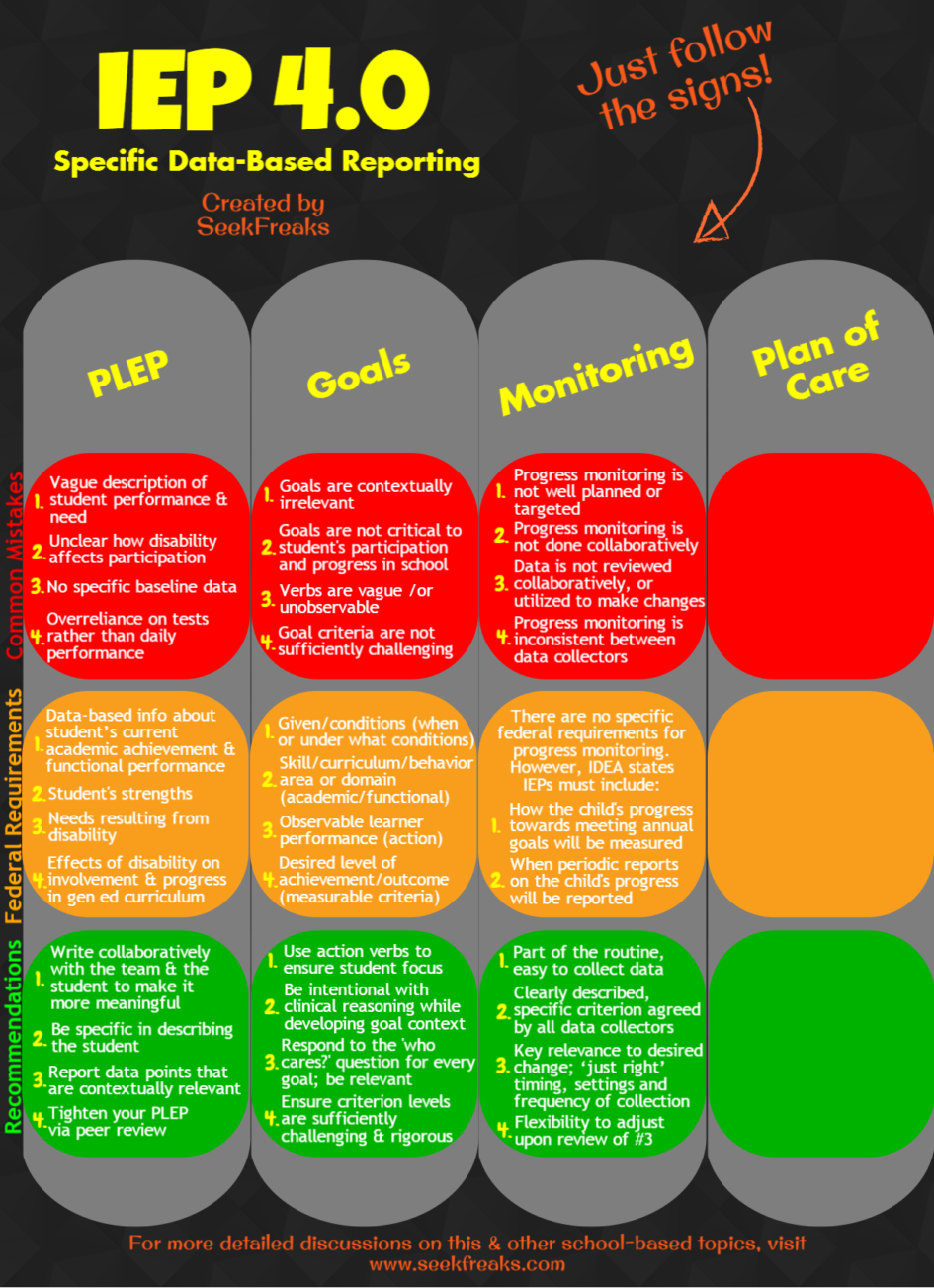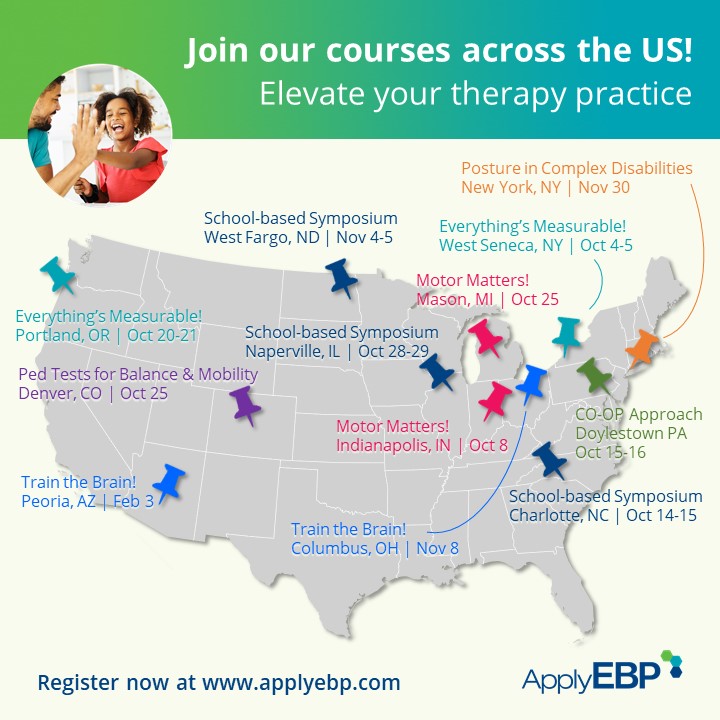Written by Laurie Ray, MPT, PhD, who has over 18 years of experience in school-based practice and is a state-level PT consultant for public schools. She also consults for Medicaid and Adapted Physical Education for her state and is an Associate Professor at UNC-Chapel Hill. Laurie also teaches continuing education via Apply EBP. More about these courses after the article below.
[smbtoolbar]
We return to the 3rd in our series on IEP Development. This article is based upon the foundation laid down by the first 2, so just in case you have not read them yet, here are the links:
- IEP 4.0 – Using Data & Collaboration to Develop a Clear PLEP
- IEP 4.0 – Developing Data-Based and Student-Focused Goals
Monitoring Student Progress…What fresh adventure is this?
This part in the IEP process seems like additional work. We have to write PLEPs and student goals, but we can just slide by with ‘OT/PT/SLP observation’ as the means to report student progress. Right? Of course not, we must monitor the changes a student is making and be able to evaluate how well, how quickly our interventions are working. Further, if have already worked to make the PLEP specific and the student goals functional and measurable; you are almost there! All that remains is to collaboratively develop a progress monitoring plan. Planning with the team is critical. We don’t have any extra time to invest in collecting data that is not relevant or/or necessary. While there are no specific regulations for progress monitoring, IDEA does make 2 statements (IDEA Part 300.320 a 3) which requires each IEP to include a description of:
- How the child’s progress toward meeting the annual goals will be measured; and
- When periodic reports on the progress the child is making toward meeting the annual goals (such as through the use of quarterly or other periodic reports, concurrent with the issuance of report cards) will be provided
Best practices in progress monitoring suggest some common characteristics:
- Sensitivity to change
- Assesses effectiveness of instruction/intervention
- Reliability
- Sustainability
- Whole team collaboration
Developing the plan: It must begin and end with collaboration!
- Operationally defining terms
Once we have established the goal as a team, we need to take some time to agree upon and specifically define what performance we are observing/collecting data. What are we looking for? What performance or action? Are we looking to extinguish a behavior? Generalize a skill? Establish mastery of a skill through consistent performance? For example, if we are working to prevent or eliminate falls- What is a fall? What is a stumble? Loss of balance? Do data collectors agree? Is a fall when the student uses his/her hands on the floor? Or when there is an uncontrolled descent to the floor? What if they ‘catch’ themselves on a piece of furniture?
- Data collection – Who, where and when
Each progress monitoring plan should be shaped by the unique situation. Many factors should be considered. Also, can you pilot the system? Try it and then have data collectors improve the system. What is the best location, routine, time to collect this performance data? Where s/he is performing best (emerging skill) or worst (generalization/mastery)? Early when they are fresh or do they need time to alert? Later in the day when s/he is fatigued? Do peers need to be present? How long will it take to see change? If we are working on a strength outcome, is data collection needed in the first 7 weeks? Don’t collect data if it is not helpful. When establishing data collectors, always consider the student first. Can s/he collect data? Who else- which teachers, paraprofessional/teacher assistants, related service providers, other team members? Can the parents/caregivers collect needed information?
- Data collection – How
If the parent, student or another team member offers a system or form, try it out. No need to re-create the wheel. Given our team needs, what is the easiest way to record the data or information? Whatever works for the collectors! High tech or low tech- Note cards, iphone, videos, photos, tallies, data collection sheets. If you are collecting video or photographs, obtain consent from the parent or caregiver. Consider getting assent from the student. Look for ideas at:
National Center for Intensive Intervention www.intensiveintervention.org & http://www.intensiveintervention.org/chart/progress-monitoring
National Center for Student Progress Monitoring http://www.studentprogress.org/
Research Institute on Progress Monitoring (RIPM) http://www.progressmonitoring.net
Strive for simplicity, the more complex a system is the less likely it is to be sustained. Ensure that those collecting the data decide on the system.
- Data analysis and dissemination
Don’t drop the ball here! Often teams get the data but fail to put it together and get it out to the team. If it is important enough to collect, it deserves to be seen! Assign this role deliberately and if time frames are not kept, everyone has the responsibility to follow up! This is also where fidelity of data collection can be assessed early and often. A quick check in can avoid losing important information needed by the team for decisions. Create a system to share data/progress with parents/caregivers. Can there be a graph created or other visual representation? If an online system is utilized, BE CERTAIN no personally identifiable information is included and that all collaborators understand the security of the system, or lack thereof!
- Data review and adjustment
This is another weak point that needs attention. The best data cannot improve student outcomes if it not reviewed and employed to make decisions in a timely fashion. Given the goals and forecasted time frames, how often should the team review the data? When should data be reviewed and who should analyze student performance to reveal links between performance, requirements, supports and interventions?
Documenting progress monitoring in the IEP
When recording how progress will be monitored, outline the people and method planned. Don’t get too specific regarding the forms or other details. If the team needs to alter the forms or timing and it is recorded in the IEP; a meeting of the IEP team would be required to make those adjustments
Continue to Part 4 of IEP 4.0: Creating an Intentional Plan of Care
~~~~~~~~~~0~~~~~~~~~~
Resources
- National Center for Intensive Intervention www.intensiveintervention.org & http://www.intensiveintervention.org/chart/progress-monitoring
- National Center for Student Progress monitoring http://www.studentprogress.org/
- Research Institute on Progress Monitoring (RIPM) http://www.progressmonitoring.net
Join author, Laurie Ray, and her colleagues in the following continuing education courses…
















August 6, 2016 at 12:39 am
I truly enjoy all of the posts! Thank you! I have a question about service delivery. Or the iep there are related services, supplemental aids and services, and support to staff. Have you ever listed physical therapy as a supplemental service and/or as a consult only with no related service time? We are having discussions regarding documenting the service delivery and I am having a hard time finding resources, specifically on physical therapy as a supplemental service. Thanks!
August 7, 2016 at 1:27 pm
Yes, physical therapy or any other service can be used as a supplemental aid or “service on behalf of the student” as it says in IDEA. Generally speaking, the services are to support the staff or program that allows the student to access their education. Services to create a student response or progress must have a goal so that progress can be monitored.
Glad you found SeekFreaks helpful, maybe we should write a post on supplementary aids and services! I’ll put that on the to do list…
Thanks for your comment!
August 11, 2016 at 11:18 pm
Thanks so much for that clarification. I really like the statement “services to create a student response or progress must have a goal so that progress can be monitored” And i would love a post on supplementary aids and services.
August 12, 2016 at 10:48 am
Message received Michelle…I will get to work on a SAS post ASAP! Thanks for your comment and suggestion.